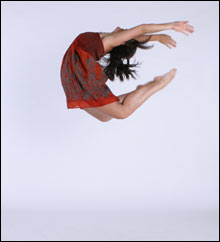
TAKING FLIGHT A Fusionworks dancer soars. |
The rock/jazz fusion band Bixit will be amping up the energy for collaborative dance concerts with Fusionworks, at Rhode Island College's Sapinsley Hall on November 19 and 20 at 8 pm.Fusionworks artistic director Deb Meunier describes their music as "true rock/jazz fusion in the mode of 1970s fusion such as Weather Report or Down to the Bone, but grittier. They consist of lead guitar, bass, drums, and keyboard and they set up these grooves that really 'move' in the sense that you want to move your body, dancer or not."
Mix It With Bixit is choreographed, for the most part, with brief moments of improv within the set structure. "I began by exchanging ideas with John Wilson, the bass player," Meunier explains, "and deciding on a groove from one of his favorite tunes, and then went into the studio and began to play with movement vocab that felt right to it. We went back and forth throughout the creative process through exchanging mp3 files and DVD clips on Facebook and have also rehearsed several times all together."
Of course, much of the movement was inspired by Bixit's specific style of music.
"It's certainly modern dance, but with a fun, full-blown physicality that rocks like the music," the choreographer says. "Lots of full body, rock your hips, shake your head, jump way up and then way down to the floor and then up again. It starts out slow and 'groovy,' as I have been saying to the dancers, and then it rock and rolls for sure.
"When I was creating it, I wanted to sculpt the space but really have fun doing so. I'd be flying around one minute, but in the next the bass would bring me right down into smooth sexy hips and sways. I guess you'd say it's a meeting of the worlds of modern dance and going to a club and boogieing to these guys with a beer in your hand."
As she describes the style, "there is no denying that you see Deb Meunier signatures — lots of curve, soft landings, reverse, reverse again, lots of asymmetry," but she also wanted to create a sense of the dancers inviting the audience to party.
The three other dances performed will be Isabel Gotzkowsky's Fly . . . but Don't . . ., described by Meunier as "edgy and sensuous"; Martha Armstrong Grey's Elliptic/Stippling Line, an "audience favorite" full of jumping motion; and Meunier's "theatrical" Walk the Walk. That last piece features the return of Marty Sprague, a "local legend," in Meunier's estimation. The choreographer created the opening movement, "Shock/Despair/Sorrow," for Sprague when she was with the company and the dance was being developed.
"I wanted to capture the internal sense of time upon hearing very bad news . . . of mortality," Meunier says, "I was going for a Butoh-like sense of time, everything slowed down and yet incredibly intense." To that purpose, Sprague is "otherworldly" in the section, "her body completely possessed of the moment of hearing and knowing and yet barely moving. She is rapturously transparent, as any good Butoh dancer is: becoming the thing, not representing it.